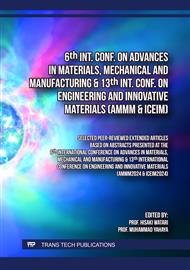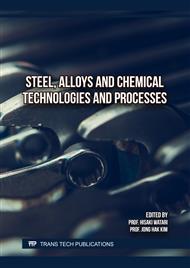p.17
p.25
p.31
p.37
p.43
p.51
p.57
p.65
p.73
Effect of Pre-Strain Condition on the Mechanical Properties of Steel Wire and its Aging Behavior
Abstract:
This study discusses the performance and durability of manganese steel wire ropes under different loading conditions and environmental exposures. Steel wire ropes are critical elements in several industries that require high tensile strength and elasticity. It is driven by the fact that these ropes fail prematurely within two years of service despite them being designed for five years during the process of fabrication. The nature and cause of these premature failures can be attributed to residual stresses, which increase the wear, fatigue, and corrosion. These tests included tensile testing at various strain rates in both the aged and unaged states, and fatigue testing performed under a 0.7 strain rate in a purely non-pre-strained state, and pre-strained under the three conditions of dry pre- strain, corrosion pre-strain, and aging pre-strain. An SEM analysis was performed to determine the failure mechanism. An increase in the strain rate reduced the lifespan but increased the yield and ultimate tensile strength; the 0.7 strain rate represented the highest energy density compared to the strain rates of 0, 0.43, 1.0 and 1.35 strain rate. This study highlights the critical role of residual stress in steel wire ropes in terms of their performance and lifetime. The residual stress increased with the strain rate. Corrosive conditions showed a drastically reduced fatigue life, and the non-pre-strain condition had the longest cycles. Understanding the mechanical effects of steel wire ropes and optimizing the testing conditions will increase the durability and reliability of steel wire ropes with reduced maintenance costs and increased safety in industrial applications.
Info:
Periodical:
Pages:
43-50
Citation:
Online since:
June 2025
Keywords:
Price:
Сopyright:
© 2025 Trans Tech Publications Ltd. All Rights Reserved
Share:
Citation:



